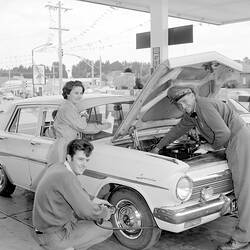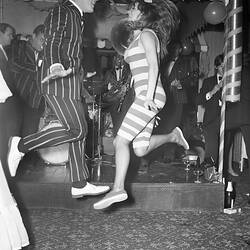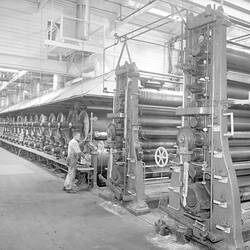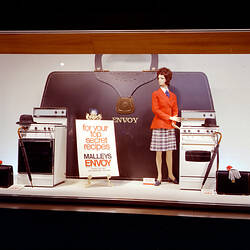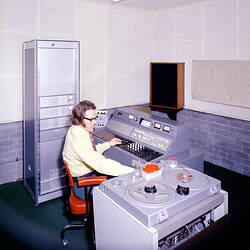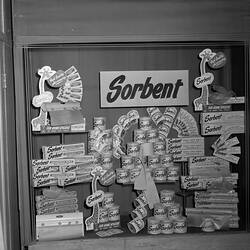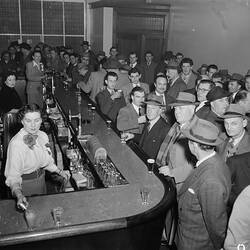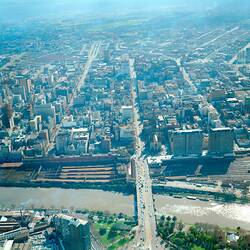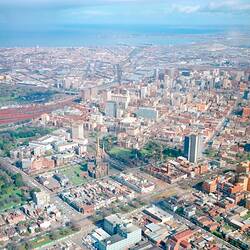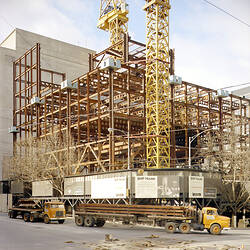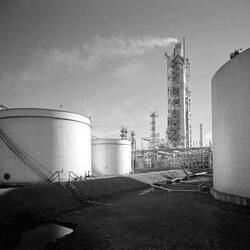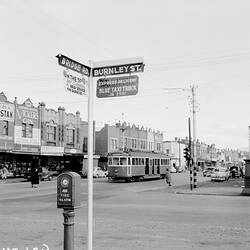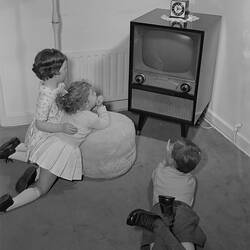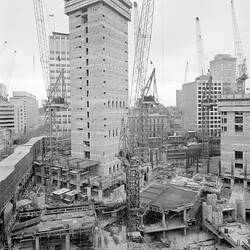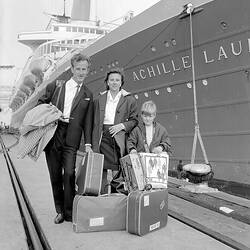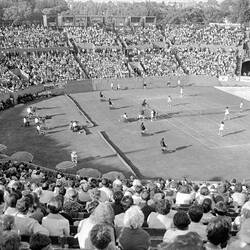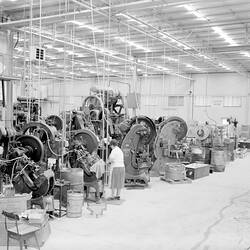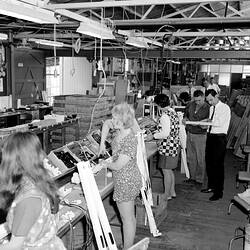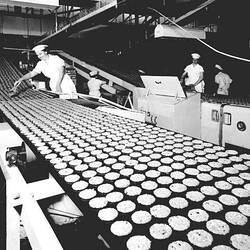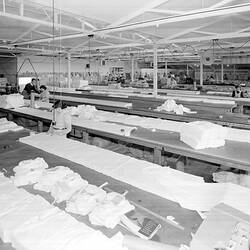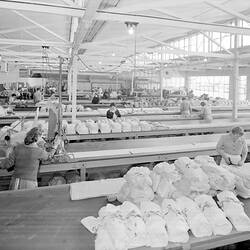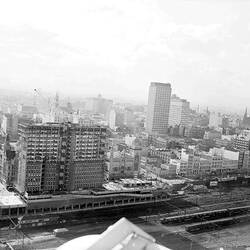Laurie Richards was a professional photographer who began his career as a photo-journalist, working for the Advertiser newspaper in Adelaide, and the Argus and the Herald newspapers in Melbourne. In 1953, he opened his own business, and set up a photographic studio at his home at four Tower Avenue, Alphington, an inner suburb of Melbourne. Laurie Richards Studio thrived from the outset: the business log books, which are housed at Museum Victoria, indicate that almost from day one, many leading companies commissioned Richards for their commercial photography, suggesting that he had already established himself as a highly regarded photographer during his newspaper days. A typical entry in the log books for those early years show that in the course of just two days, on 3rd and 4th August 1954, he undertook work for Coca Cola, 3DB, 3KZ, 3AW, Vacuum Oil Company, Swallow and Ariell Biscuits, Ansett National Airlines and Kraft Foods. Laurie Richards' business expanded rapidly and at its peak, in the late 1960s, it was one of Melbourne's pre-eminent commercial photographic studios, employing twelve photographers.
Laurie Richards worked mainly in advertising and public relations. He had a broad clientele which included commercial companies, government institutions and the entertainment industry. Other clients included Australian Broadcasting Corporation, HSV-7, GTV-9, Commonwealth Bank, Mobil Oil and Australian Paper Manufacturers to cite but a few of the numerous prominent companies listed in his log books. Because of the breadth of both the subject matter photographed and the diverse businesses which commissioned the work, the Laurie Richards Collection at Museum Victoria is an invaluable record of Melbourne's commercial and industrial past and as such gives an insight into the social history of that period.
Laurie Richards was a fastidious photographer. This is evident in the content and composition of his images. There is an element in his photographs of wanting to get the context of the image 'just right'. But he was also meticulous in the manner in which he operated his business, indicated by the care with which he maintained his extensive archive of photographic negatives. Each and every photographic job, undertaken in the course of thirty years, is itemised in the log books in chronological order with significant details of virtually every image: date taken, name of commissioning body and the subject matter. Each and every image is ascribed a unique number, carefully hand written on the margin of the negative.
When Laurie Richards retired in 1976, Henk Rem, one of his assistants, carried on the business. When the business closed in 1991, Rem offered the Laurie Richards collection of negatives to the Arts Centre's Performing Arts Collection. The collection, comprising approximately 120,000 negatives, was acquired by the Arts Centre, a measure of the significance of the Collection to the history of the performing arts in Melbourne and Australia alone. The collection included photographs commissioned by organisations including, the Australian Broadcasting Corporation, HSV7, Hector Crawford Productions, 3DB, 3UZ, 3AW, 3KZ and Coronet and Festival Records. Equally significant, however, was the component of the Collection relating to the social history of Melbourne - the images which documented commerce, industry and technology. The Arts Centre decided to retain all images with performing arts content, but offered the remainder of the collection, totalling approximately 85,000 negatives, to Museum Victoria. The Laurie Richards Collection at Museum Victoria consists of approximately 85,000 negatives, mostly in large format [5"x 4" / 12.5 x 10 cm], black and white images, though a significant number are in colour.
Even though most of the photographs, both in the Arts Centre and Museum Victoria collections, were originally commissioned to be used in advertisements or for promotional purposes, Laurie Richards was documenting, knowingly or not, significant changes in Melbourne over a period of three decades. For example: some of his streetscapes of Melbourne in the 1960s feature landmark buildings, such as CRA, BHP, Gas & Fuel, Southern Cross Hotel and Cromwell buildings, in the course of construction or newly completed. The photographs were commissioned to showcase these organisations' prominence in the city. When we consider that all these buildings [and many others] have since been demolished, we get an idea - thanks to Richards' images - of the rapid changes to the city skyline over a relatively short space of time. Some essential features of Melbourne at the time were captured. The Southern Cross Hotel, for example, was the height of stylishness in architecture in Melbourne when built. Richards was there to 'capture' that style.
Even though every photograph taken by Richards was, of necessity, instilled with a commercial bias, he also captured pivotal moments in Melbourne's history: television had barely been introduced in Melbourne when HSV-7 commissioned Laurie Richards to take promotional photographs of the channel's first programs; the latest domestic products were being photographed by Richards before they hit stores; a photograph by Richards of a workman operating a giant paper press at a paper mill is as much about the revolutionary technology as it is about the alienation of many jobs of the time.
We are lucky that Laurie Richards was active when he was, in the 1950s, 1960s and 1970s, a period which saw great social changes in Melbourne with the advent of television, popular music, teen culture, the women's liberation movement, mass media and mass consumption.
More Information
-
Keywords
commercial photography, Advertising, Advertising Models, Advertising Signs, Aerial Photographs, Aeroplanes, Agricultural Shows, Agricultural Workers, Airports, Amusement Parks, Architectural Models, Art Galleries, Assembly Lines, Athletes, Banks, Billboards, Boats, Bridges, Broadcasting, Celebrations, Charities, Children, Children's Play, Christmas, Churches, Cinemas, Classrooms, Clocks, Clothing, Competitions, Computers, Construction Sites, Construction Workers, Decorations, Department Stores, Disability Organisations, Display Boards, Display Homes, Display Windows, Domestic Appliances, Domestic Life, Domestic Technology, Domestic Work, Eating & Drinking, Electric Trams, Electrical Appliances, Engineering Works, Entertainment, Exhibitions, Factories, Factory Workers, Fancy Dress Costumes, Fashion, Fashion Design, Fashion Industry, Fashion Models, Festivals, Food Workers, Hardware Stores, Hospitals, Hotels, Houses, Industrial Design, Industrial Equipment, Infant Welfare, Laboratories, Manufacturing, Manufacturing Workers, Manufacturing Works, Media Personalities, Moomba Festival, Motor Cars, Motor Garages, Motor Racing, Motor Trucks, Motor Vehicles, Motoring, Musical Instruments, Musicians, Occupational Health & Safety, Offices, Olympic Games: Melbourne, 1956, Packaging, Performances, Performers, Performing Arts, Petrochemicals, Pharmacies, Photographic Equipment, Photography, Playgrounds, Political Protests, Politicians, Portraits, Presentations, Product Demonstrations, Production Lines, Promotional Models, Protective Clothing, Public Art, Public Events, Public Gardens, Radio Stations, Radio Studios, Railway Stations, Recreation Activities, Refineries, Restaurants, Retail Displays, Retail Workers, Retailing, Road Construction, Road Transport, Roads, Royal Exhibition Building, Royal Melbourne Show, Rural Industry, Rural Landscapes, Sales Representatives, Service Stations, Shopfronts, Shopping Centres, Shops, Showrooms, Signage, Social Functions, Sport, Sporting Clubs, Sporting Competitions, Sports Grounds, Sports Stadiums, Streetscapes, Supermarkets, Television Industry, Television Production, Television Stations, Television Studios, Textile Workers, Textiles, Theatres, Theatrical Costumes, Tools, Town Halls, Toys, Trade Exhibitions, Trade Fairs, Trade Shows, Transport Workers, Travel & Tourism, Uniforms, Urban Landscapes, Workers
-
Localities
-
Authors
-
Article types


